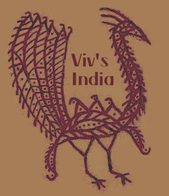On arrival, after clearing immigrations, you will be met by our Indian representative and escorted to your hotel.
Delhi, the capital and the third largest city of India, is a fusion of ancient and modern. Standing at the western end of the Gangetic Plain, it is a vibrant city rich in culture, architecture, beautiful gardens and human diversity. Its rich history is reflected in magnificent monuments, in museums and in galleries. It comprises two contrasting yet harmonious parts, Old Delhi and New Delhi. Old Delhi was the capital of Muslim India from the 12th to the 19th centuries, while New Delhi was created by the British Raj and replaced Calcutta as the capital in 1931. It is India’s main international gateway, and the travel hub of Northern India.
Check in at your hotel & spend remainder of the day at leisure.
Golden Haveli is an intimate living space reimagined. Drawing inspirations from its origins and our learnings, it finds the perfect balance inviting you to experience an enduring and enticing heritage made accessible. Embracing a central courtyard, the ornate galleries with doors lead to restful spaces that embellish and accentuate the cultural legacy and heritage of Golden Haveli.
Experiential Dinner is included
Early evening, just few yards away, proceed to experience Kite Flying & Classic Dance Performance with ‘Mouthwatering Chandni Chowk delicacies at Haveli Dharampura’ in Chandni Chowk with some amazing views of Old Delhi from Terrace.
Be engulfed in a one-of-its-kind cultural experience. View an enchanting performance of Kathak, a traditional Indian dance form. The dance is paired with Hindustani classical music. Be transported to a different era with a viewing. The performances are visible from every floor of the Haveli.
Overnight Old Delhi



Know Your Host
The hosts of Golden Haveli, the Goel family, are deeply rooted in the culture and history of Delhi. Inspired by the city's rich heritage, which includes ancient temples and historical architecture, Mr. Siddhant Goel and his father embarked on a mission to preserve and revitalize these landmarks. Their commitment to heritage restoration began with projects like Golden Haveli that then stretched to the Haveli Dharmapura aiming not only to impress tourists but also to highlight the importance of these sites in the broader historical tapestry of the city. Their efforts support the initiative to have Delhi recognized as a UNESCO World Heritage City. Through their work, they aim to maintain the integrity and splendor of their city's heritage for future generations.
Enjoy your breakfast at Haveli Dharampura.
Full day guided city tour of Old and New Delhi.
Begin with sightseeing of Old Delhi includes Jama Masjid, Chandni Chowk, Red Fort and Raj Ghat.
Jama Masjid: This great mosque is the largest in India, built by Shah Jahan between 1644 and 1658. With a courtyard capable of holding 25,000 devotees, the highly decorative mosque has three great gates, four towers and two 40 metre high minarets constructed of alternating strips of red sandstone and white marble.
Chandni Chowk: Chandni Chowk, the bustling oriental bazaar, is next to the Red Fort and Jama Masjid. It was built in 1650 by Shah Jahan's favourite daughter, Jahanara Begum, as a compliment to the imperial habitat, the Red Fort. Enjoy Rickshaw ride through narrow lanes of old bazaar.
Red Fort: The red sandstone walls of the massive Red Fort (Lal Qila) stretch some two kilometres and rise to 33 meters above the clamour of Old Delhi. It was a fort and royal residence, and a striking reminder of the magnificent power of the Mughal emperors. (Closed on Mondays)
Raj Ghat: Set in a lovely garden a black marble platform on the banks of the Yamuna River marks the place where “the father” of the Nation, Mohandas Karamchand Gandhi (popularly known as Mahatma Gandhi) was cremated after being assassinated in 1948.
Later continue with sightseeing of New Delhi includes the Qutab Minar, Humayun’s Tomb, Lotus Temple, India Gate and a drive past various Government buildings including Parliament House and Rashtrapati Bhawan.
Qutab Minar: An excellent example of Afghan architecture, the Qutab Minar is a soaring, 73 metre high tower of victory. Started in 1193 by Qutab-ud-din Aibak, immediately after the defeat of Delhi's last Hindu kingdom, it was completed by his successors. Gracefully hand-carved for its entire height, it has five distinct storeys, each marked by a projecting balcony and tapers from a 15-metre diameter at the base to just 2.5 metres at the top. The lower three storeys are red sandstone, while the upper two are of marble and sandstone.
Humayun’s Tomb: Built in 1565 A.D. nine years after the death of Humayun, by his senior widow Bega Begam. Refined over the years, this striking and beautiful tomb’s design evolved into the Taj Mahal. Notable feature are the centrally located well proportional mausoleum topped by double dome and the garden squares (chaharbagh) with their pathways water channels.
India Gate: At the eastern end of the Raj Path in New Delhi stands the 42 metre high India Gate. An "arch of triumph" it commemorates and bears the names of the 90,000 Indian soldiers who lost their lives during the World War I and North West Frontier (Afghan) campaigns.
Lotus temple: It is built in the shape of a lotus flower and is the last of seven Major Bahai's temples built around the world. Completed in1986 it is set among the lush green landscaped gardens. The structure is made up of pure white marble. The architect Furiburz Sabha chose the lotus as the symbol common to Hinduism, Buddhism, Bhai Temple Jainism and Islam. Adherents of any faith are free to visit the temple and pray or meditate. Around the blooming petals there are nine pools of water, which light up, in natural light. It looks spectacular at dusk when it is flood lit.
Cultural Experience with dinner is included
Following New Delhi Sightseeing, your vehicle will drop you to designated venue & from there you will be picked by rickshaw for Private Cultural Experience with Dinner at Kathika Cultural Centre and Museum. Liquor cannot be served.
Kathika Cultural Experience: We offer here a meticulously curated experience which promises to offer an immersive experience into the essence of India’s rich history and heritage. Details of the experience are as follows:
- Cultural Program: It features a Jugalbandi of Indian classical instruments performed by accomplished classical Indian musicians, followed by a captivating Kathak dance performance.
- Museum Walkthrough: A curatorial walkthrough of the museum which promises to offer a sneak-peek into our diverse collection of vintage artefacts and archival photographs, showcasing a unique perspective and history of Old Delhi.
- Culinary Experience: Dinner will be arranged, featuring a blend of Mughlai and Old Delhi Delicacies.
Overnight in Old Delhi

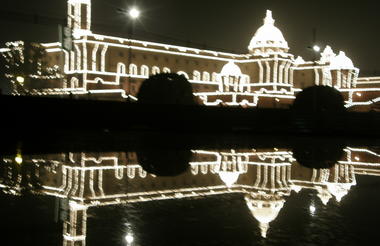
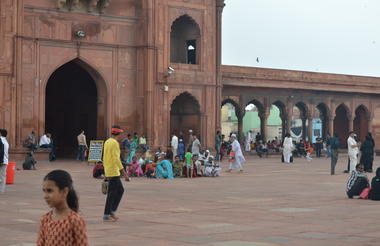
Following your breakfast, check out & you will be driven to Agra.
Agra was the capital of the Afghan King Sikandar Lodhi’s empire from 1501. It passed to the Mughals soon after and in 1526 Emperor Babar transformed Agra, giving it a unique character and beauty. A great patron of the arts, he made changes to the culture and life-style of his people, which in turn brought forth some of the finest craftsmen, artists, statesmen, warriors and nobility ever seen in this part of India.
Over the next few centuries Agra witnessed a rise in pomp and pageantry under the rule of three great Mughal monarchs - Emperors Akbar, Jehangir and Shah Jahan. All lavished their love and riches on this fabled city, making it one of the great centres of art, culture, learning and commerce.
Arrive Agra & check in at a small boutique hotel- “Ekaa Villa’.
Ekaa Villa was born out of our desire to showcase Agra like never before. Every aspect of our boutique hotel in Agra is adapted from the city of the Taj – from our rooms where you will find hints of delicate inlay work, to our kitchen that serves food inspired by the homes of Agra. Ekaa Villa is all about the city it inhabits. Agra is much more beyond the Taj, allowing us to show you the real city that surrounds the most romantic monument in the world. Experience a stay in Agra like never before with Ekaa.
Later Agra Sightseeing includes visit to Agra Fort and Taj Mahal by Sunset.
Agra Fort was built principally as military establishments by Akbar in 1565. However, it was partially converted into a palace during Shah Jahan’s reign. Though Akbar built the original structure, his grandsons made many additions. This powerful fortress encompasses the imperial city of the Mughal rulers within its 2.5 kilometre enclosure walls.
Sunset visit of Taj Mahal was built by Shah Jahan between 1631 to 1653 in memory of his queen Mumtaz Mahal to enshrine her mortal remains. This architectural marvel is a perfectly proportioned masterpiece fashioned from white marble and in-laid with precious and semi-precious stones. It stands testimony to the skill of some 20,000 craftsmen brought together from Persia, Turkey, France and Italy, and who laboured for 22 years to complete this ‘Love Poem in Marble'. (Closed on Fridays)
In the evening, enjoy special dinner at your hotel.
‘Pattal Ki Daawat’: A unique Traditional Dining Experience. Pattal ki Daawat or leaf plate feast is a 5 course, homecooked style, vegetarian meal, served in handmade leaf plates & clay pottery bowls. A long-lost tradition of Agra, only found at Ekaa.
Overnight in Agra
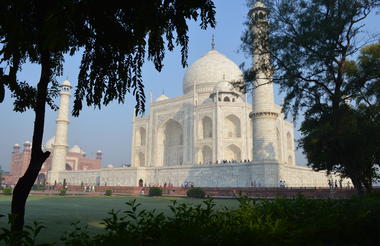
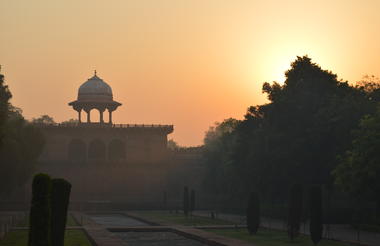
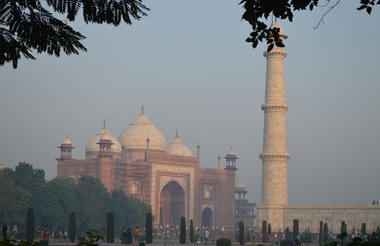
Post your breakfast, check out & drive to ‘Ramathra Fort.
Ramathra was granted as a jagir (fiefdom) in 1645 AD to Thakur Bhoj Pal by his father the Maharaja of Karauli. The name Ramathra honours Lord Rama, who, it is believed, camped here while on his epic journey to Lanka. Today, Ramathra Fort belongs to Thakur Brijendra Raj Pal and his family who are descendants of the founder.
The fort has a strong perimeter wall crowned with parapets. Its ramparts are wide and offer a spectacular view from the hilltop. Inside there is a multi-story palace, parts of which are being restored using traditional building techniques and local craftspeople. Stone lattices and a painted ceiling ornament the otherwise simple facilities. It was, after all, designed to be a battle fort.
Arrive Ramathra Fort, check in and enjoy sumptuous lunch.
You can enjoy various complimentary activities conducted by your hotel:
- Boating and Bird watching
- Walking tour of Ramathra village
- Nature walks along the lake and adjoining hillside
- Trekking to old fort ruins
- Temple trail visiting various old temples
- Visit to Organic Farm
Dinner at your hotel.
Overnight in Ramathra Fort
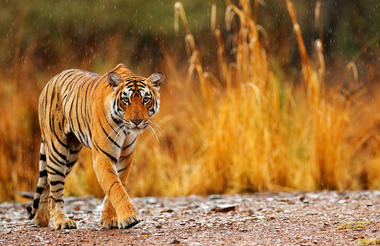
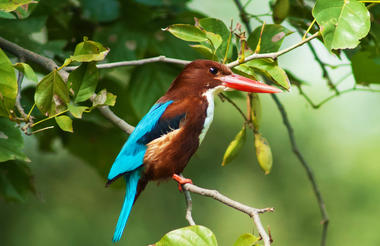
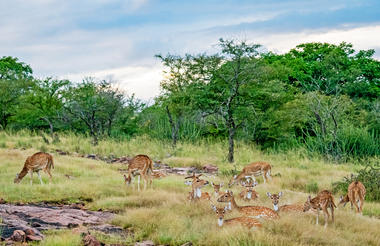
HAPPY MAKAR SANKRANTI!
Makar Sankranti, also known as the Kite Festival. It is a Hindu observance and a mid-winter harvest festival in India and Nepal. It is typically celebrated on 14 January annually.
Indulge yourselves in array of complimentary activities arranged by your host. We can also arrange Indian style cooking demonstration on wood fire chullas at additional cost.
Later you will have an option to choose either of the activities:
- Wilderness Drive: Tour the countryside, visit ‘Gujar’ hamlets, and explore a cavernous gorge and an old cave temple, look out for possible wildlife sightings enroute.
- OR
- Night Drive into the Buffer Zone of Kaila Devi National Park: Drive across the Daang plateau stretching east to the Chambal River valley and as far as Ranthambhore to the south. This area is filled with gorges, until recently, tigers roamed the area but visitors regularly see several varieties of deer, blue bulls, wolves, jackals, hyenas, foxes and if lucky, a wild boar, bear or leopard.
Overnight in Ramathra Fort
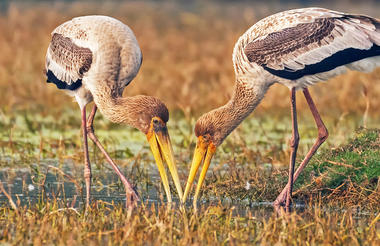

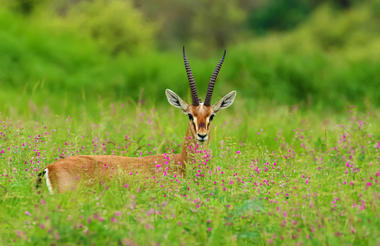
Following your breakfast, check out & drive to Jaipur.
Jaipur is the state capital of Rajasthan and owes its name, planning and foundation to the Maharaja Jai Singh II. In 1727 he decided to move from his hillside fortress at Amber to the plains, and thus Jaipur was conceived. t is also known as the "Pink City", derived from the pink painted sandstone from which the buildings in the old walled city are constructed. The city is endowed with great architectural elegance and beauty, with magnificent historic palaces, temples, gardens, museums and an amazing observatory built by Jai Singh.
Arrive Jaipur, proceed to experience Block printing & Indigo Dyeing at Sanganer.
Neighbouring Sanganer retains a near mythical status in hand printing, and is still a vital contributor to India’s vibrant textile industry. Yet, major changes have occurred. The once tight-knit community of chhipas printers and rangrez dyers working in harmony using traditional methods fractured with the introduction of screen printing and chemical dyestuff. Since 1947 this influential town has rapidly transformed from a traditional printing village into a commercial hub with high volume production of modern cloth.
Later check in at your hotel and spend rest of the day at leisure.
Overnight in Jaipur
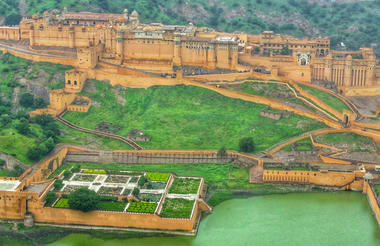
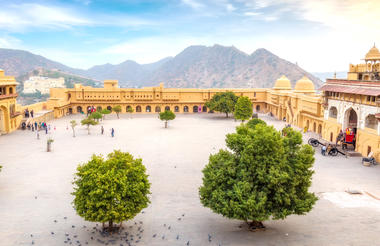
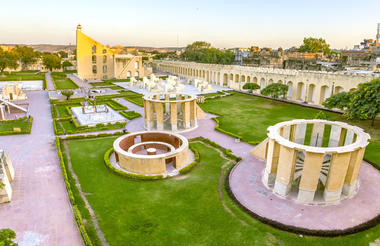
Breakfast at your hotel.
Later proceed to attend Jaipur Literature Festival (Jaipur Literature Festival sessions are free to attend, some special events and performances, like the Jaipur Music Stage, require separate tickets. General entry is free, but pre-registration is mandatory.)
The 19th edition of the Jaipur Literature Festival will be held from 15th-19th January, 2026, at Jaipur’s Hotel Clarks Amer and will host an impressive line-up of insightful sessions, performances, book signings, and the simultaneously held Jaipur BookMark and Jaipur Music Stage.
Described as the ‘greatest literary show on Earth’, the Jaipur Literature Festival is a sumptuous feast of ideas. The past 18 years have seen it transform into a global literary phenomenon, having hosted nearly 2000 speakers and welcoming over a million book lovers from across India and the globe. Every year, the Festival brings together a diverse mix of the world’s greatest writers, thinkers, humanitarians, politicians, business leaders, sports people and entertainers on one stage to champion the freedom to express and engage in thoughtful debate and dialogue.
Overnight in Jaipur
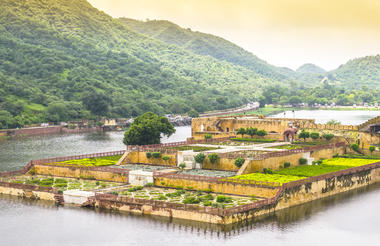
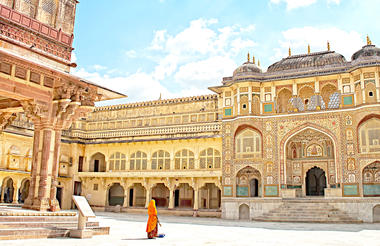
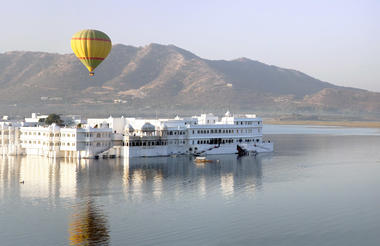
Breakfast at your hotel.
Later proceed to attend Jaipur Literature Festival.
Overnight in Jaipur



Breakfast at your hotel.
Later explore Royal City of Jaipur in full day sightseeing.
Morning, sightseeing of Amber Fort with Jeep ride:
Ten kms outside the city, in the rugged hills that surround Jaipur, is the magnificent Amber Fort. An elephant will take you up the steep road to the fort, passing through huge gateways and pillared pavilions. This Rajput Fortress Palace was constructed from 1592 by Raja Man Singh II, and is a superb example of Rajput architecture. Within the Fort is Jai Mandir (Sheesh Mahal - Palace of Mirrors), renowned for its architectural designs using mirrors of varied shapes and sizes in the intricate design of its wall decoration (We are against unethical treatment towards animals & hence do not promote elephant ride).
Later enjoy your lunch at RajRasa by Chef Saurabh, near Amer.
RajRasa, derived from Sanskrit word ‘rasa’, embodies the essence of royal Rajasthani cuisine. Under the guidance of renowned Chef Saurabh, we bring you a culinary journey through the rich heritage of Rajasthan, where each dish tells a story of tradition, sustainability, and royal craftsmanship. Our commitment extends beyond cuisine to embrace sustainable practices, supporting local farmers, and preserving forgotten recipes of Rajasthan.
Afternoon, sightseeing of Jaipur City: A city tour takes you through the bazaars to the Maharaja's City Palace. Part of it is now a fine museum with a comprehensive display of historic artefacts. A relatively small portion of the palace is still used by the Royal family of Jaipur.
Built in the style of a fortified campus, one of the palaces is the Hawa Mahal, known as the Palace of the Winds. Built in 1799 this five-story building looks out over the main street, and was originally for the ladies of the royal household to be able to watch life outside the cloistered Royal Residence.
Nearby is the Jantar Mantar, which has the largest stone and marble crafted observatory in the world. Built by Jai Singh in 1728, it is still equipped with the its original ancient instruments including a very accurate 90-foot sundial. Many of them are still in working condition.
Overnight in Jaipur

.jpg)
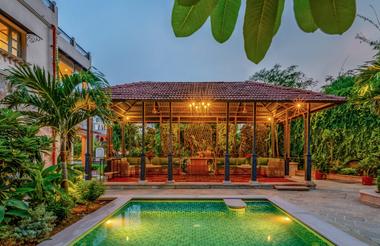
After your breakfast, check out & drive to Jodhpur.
Rao Jodha, the chief of the Rajput clan called the Rathores, founded the bustling desert city of Jodhpur in 1459. It became the centre of the Rathore Kingdom known as Marwar, and lies in the heart of Rajasthan and on the edge of the Thar Desert. The massive fort dominates the city, topping a rocky hill that rises in its centre. The old city is surrounded by a 10 km wall, from which eight gates give entry and exit.
Arrive Jodhpur, check in to your hotel and the rest of the day is at leisure.
Overnight in Jodhpur
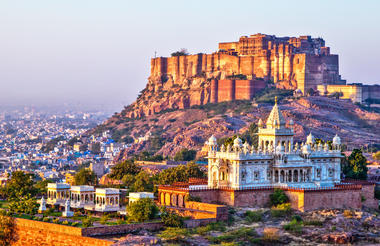
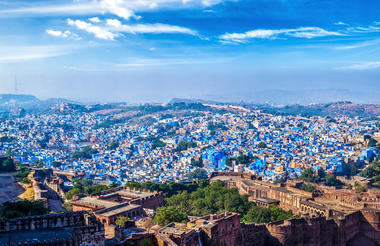

Breakfast at your hotel.
This morning, proceed for a Jodhpur City tour which includes visits to Mehrangarh Fort, Jaswant Thada & a local bazaar.
Mehrangarh Fort: Perched on a 125 m high hill the fort was founded in 1459. It is both impressive and formidable in both its location and construction. On the ramparts is a rare collection of canon, and battle scars from canon ball hits can still be seen on one of the gates. Within the fort are magnificent palaces, with meticulously carved panels and latticed windows or "Jarokhas". The chambers have evocative names - Moti Mahal, Phool Mahal, Sheesh Mahal, the Sileh Khana and the Daulat Khana reflect the splendour of a bygone era.
Jaswant Thada: This graceful white marble cenotaph is the memorial to Maharaja Jaswant Singh II, and was built in 1899. The main memorial is built like a temple, with intricately carved marble. Located in stark and rocky terrain, it has a secluded and a mystic aura.
Sardarpura market, also known as Sardar Market, is a vibrant and bustling marketplace near the Clock Tower. It is known for its narrow lanes filled with shops offering a variety of goods, particularly Rajasthani textiles, jewellery, leather goods, and spices. The market is a popular destination for both locals and tourists seeking a taste of Jodhpur's culture and shopping experiences.
Afternoon experience Bishnoi Village Safari.
Visit to a Bishnoi Village: The Bishnoi (followers of Guru Jamboji of the 15th century, and his 29 principles) have protected nature for more than 500 years, and are arguably some of the world’s 'Premier Ecologists”. Bishnoi’s are strong lovers of trees and animals and are responsible for the survival of species like the Black Buck Antelope (India's most beautiful antelope and a rare and protected species today). They share a close and special relationship with this endangered animal, wherein the antelope stays close to Bishnoi habitation, never leaving it, and displays complete trust in the Bishnoi people.
Overnight in Jodhpur
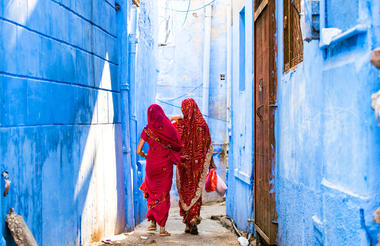
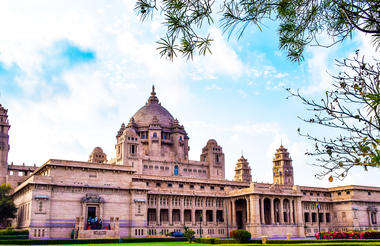
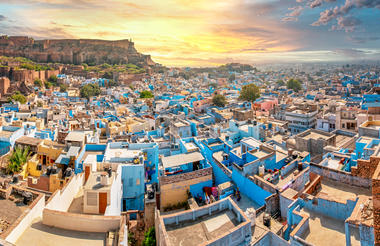
Post breakfast, check out & drive to Udaipur.
En-route visiting Ranakpur Jain Temples with Audio Guide.
The Jain Temple complex at Ranakpur is one of India’s hidden gems. Built in the 15th century the temples are situated in the lovely Aravali valley, and the town is named after Rana Khumba a legendary warrior king of Udaipur. The beautiful architecture and exquisite stone carving single these temples out. The main temple has 39 chambers with 1,444 carved stone pillars supporting the roof, and no two are alike. Complimenting this, the ceilings are a wonder to behold.
Following the temple visit, continue your drive to Udaipur.
Udaipur, the 'City of Dreams' also known as the Venice of the East, is interspersed with shimmering lakes, marble palaces and fountains. It is often referred to as the most romantic city in India. It was built in traditional Rajput style in 1559 A.D. by Maharana Udai Singh and was originally the capital of the State of Mewar. It's beautiful lake setting; graceful architecture, bustling bazaars and historical past make Udaipur rather special.
Arrive Udaipur, check in at hotel & the rest of the day is at leisure. Enjoy your stay at the edge magnificent lake Pichola.
Overnight in Udaipur

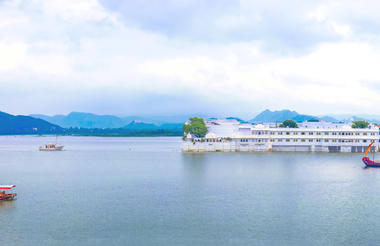
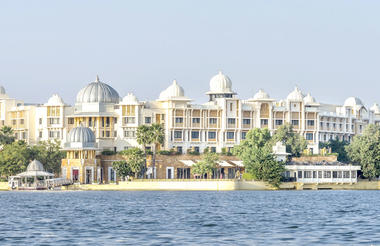
Breakfast at your hotel.
Later proceed for a Morning City Tour which includes the City Palace & Museum, Jagdish Temple & the Sahelion ki Bari (Garden of the Maids of Honour).
The grand City Palace towers over the Pichola Lake. Maharana Uday Singh initiated its construction and succeeding Maharanas added several palaces to the complex but retained a surprising uniformity to the design. The main part of the palace is now a museum displaying a large and diverse array of artefacts, the Crystal Gallery having a breath-taking collection of crystal.
Jagdish Temple: The exterior and the plinth are covered with superb base reliefs of alligators, elephants, horsemen and celestial musicians rising in tiers. Chanting, bells and music can be heard throughout the day.
Sahelion Ki Bari: Known as the Gardens of the Maids of Honour, and built in the 18th century by Maharana Sangram Singh, these delightful gardens are discreet and in impeccable taste. The fountains of the Sahelion ki Bari function solely by water pressure with no pumps being used.
In the evening, enjoy an exclusive Boat Ride.
An evening boat ride on Lake Pichola cruises the city waterfront, bathing Ghats, and out to Jag Mandir. Lake Pichola derives its name from Pichola Village, which was submerged when Maharana Udai Singh enlarged the lake after he founded the city.
Overnight in Udaipur
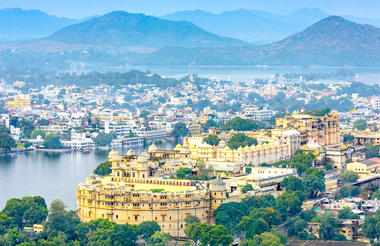
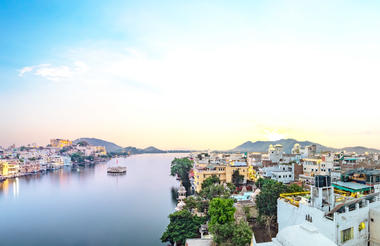
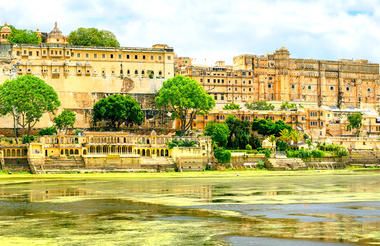
Following breakfast, check out and drive to Pushkar.
On the edge of the desert is the tiny and tranquil town of Pushkar, set on the shore of picturesque Pushkar Lake. It is a very important pilgrimage centre for the Hindus. Every year thousands of sadhus and devotees are drawn to the lake around the full moon of Kartik Purnima in October-November. This is when the Pushkar Camel Fair is held. It is the largest in India and unique in is format, combining a major religious festival with a commercial market.
Arrive Pushkar & check in at your hotel.
Later proceed for half-day guided visit of Pushkar.
Pushkar has many temples, but the most famous among them is the only existing Brahma Temple, dedicated to Lord Brahma. It was constructed in the 14th century and stands on a high plinth, with marble steps leading up to it. A beautiful carved silver turtle sits on the floor facing the sanctorum.
Pushkar Lake is considered as sacred & Hindu pilgrimage site, which is surrounded by bathing ghats & temples.
Dinner at your hotel.
Overnight in Pushkar
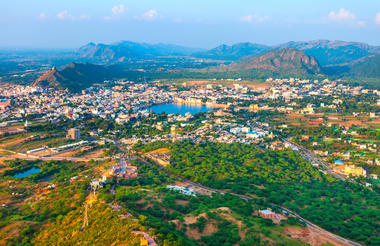
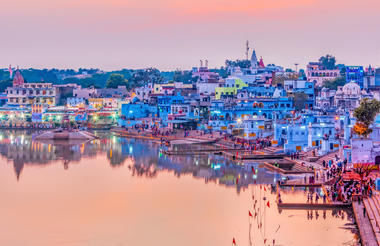

Post breakfast, check out and head towards Sariska.
Sariska Tiger Reserve is a national park where you will find a perfect intermingling of nature. It contains mountains, grasslands, dry deciduous forests and cliffs which span over 800 square kilometres. Situated in Alwar, the Tiger Reserve is nestled in the lap of Aravali hills. Currently home to numerous animals apart from tigers, the reserve showcases nature in its best form. Animals like jungle cats, rhesus macaque, sambhar, chital, wild boar, etc., are found here. Not only animals, you get to see a number of bird species, such as sand grouse, harbor quails, crested serpent eagles, etc. here as well.
Situated just 7 kms from Gate No. 2 of Sariska National Park, Utsav Camp Sariska is the ideal spot to unwind in the Alwar region. We offer the perfect nature retreat experience, providing guests with a restorative break from the digital world.
Utsav Camp Sariska welcomes you with open arms to our multiple accommodations, each a masterpiece of its own. Surrounded by boulders, lush deciduous forests, and the majestic Aravalli hills, our camp offers an unforgettable experience that will linger in your memory. Return home with memories of a beautiful journey that will stay with you for a lifetime.
Upon arrival at Sariska check in at your camp.
Enjoy your lunch and take some rest.
Witness the breathtaking sunset against the backdrop of the majestic Aravalli boulders during our exclusive sundowner experience. Enjoy a scenic jeep drive to the nearby boulders, followed by a selection of meticulously crafted Indian and international delicacies. Immerse yourself in this unforgettable moment of beauty and tranquillity. Inquire with our associate for the exquisite Sundowner's menu. This experience can also be combined with our exclusive horse rides upon request. For those desiring a more intimate experience, limited beverage service can be arranged for an additional charge upon request.
Dinner at your lodge.
Overnight in Sariska
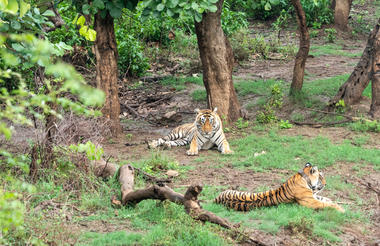
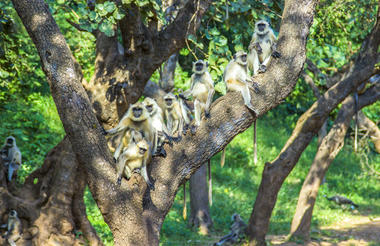
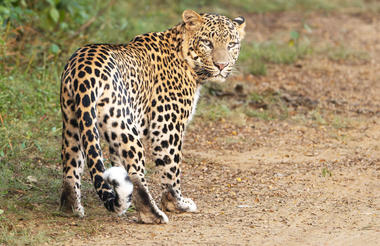
Know Your Host
Utsav Camp Sariska, born from love, devotion, and determination, was founded by Luv Shekhawat, a trained naturalist with over 20 years of hospitality management experience. Luv was enthralled with the boulders of Tehla and every time he visited, he felt a deep sense of peace anchoring his heart.
In 2011, when the opportunity to buy an empty parcel of land in the area came up, Luv took that as a sign to manifest his dream. He began developing a place where people could come to find peace and rejuvenate with the healing power of nature.
Over the next four years, under the guidance of his grandfather, Luv gave his heart and soul to cultivate the land with all kinds of trees and plants. It took him endless trips between Jaipur and Tehla to develop the property and see his vision through.
Utsav Camp Sariska offers guests an immersive nature experience and the opportunity to explore the wildlife of the Aravalli landscape.
Breakfast, lunch & dinner at your lodge.
Morning & Afternoon Game Drive by Exclusive Gypsy in Sariska National Park.
In your free time, you can enjoy reading, swimming, cycling in surrounding areas, walk around the lodge, etc.
Overnight in Sariska
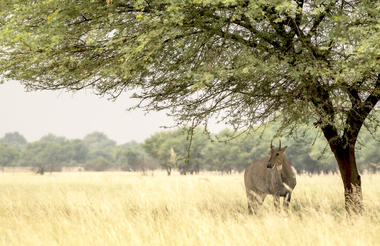
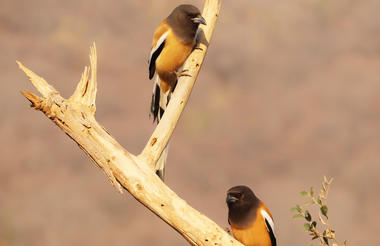
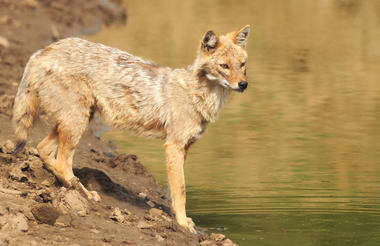
Happy Australia Day & Indian Republic Day!
Leisurely morning with breakfast.
Later check out & drive back to Delhi.
On arrival in Delhi, check in at your hotel (close to airport) & spend concluding night at ease.
For those who are interested, the Indian Republic Day Military Parade is fascinating to watch with all the various regional regiments and their differing types of dress and modes of transport - including elephants and camels.
Overnight in Delhi Aerocity
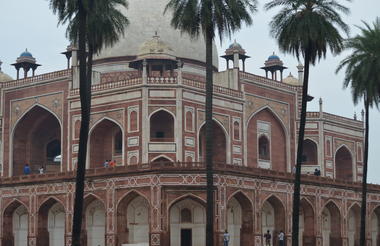
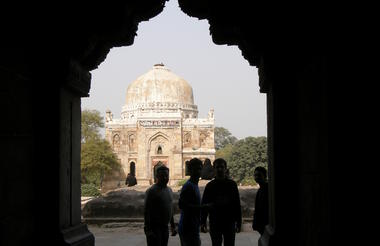
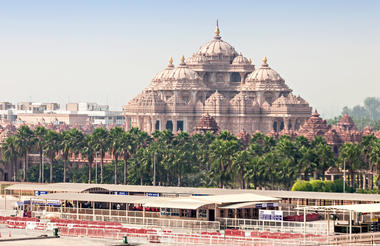
After breakfast, check out and you will be transferred to airport for your flight back home. Bid farewell to your memorable trip to India.
END OF SERVICES & WE LOOK FORWARD TO SEEING YOU AGAIN


